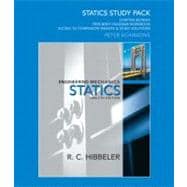
Note: Supplemental materials are not guaranteed with Rental or Used book purchases.
Purchase Benefits
What is included with this book?
Contents
Part I Section-by-Section, Chapter-by-Chapter Summaries
with Review Questions and Answers 1
1 General Principles 3
Main Goals of this Chapter 3
1.1 Mechanics 3
1.2 Fundamental Concepts 3
1.3 Units of Measurement 4
1.4 The International System of Units 6
1.5 Numerical Calculations 6
1.6 General Procedure for Analysis 6
Helpful Tips and Suggestions 7
Review Questions 7
2 Force Vectors 8
Main Goals of this Chapter 8
2.1 Scalars and Vectors 8
2.2 Vector Operations 8
2.3 Vector Addition of Forces 10
2.4 Addition of a System of Coplanar Forces 10
2.5 Cartesian Vectors 11
2.6 Addition and Subtraction of Cartesian Vectors 12
2.7 Position Vectors 12
2.8 Force Vector Directed Along a Line 13
2.9 Dot Product 13
Helpful Tips and Suggestions 13
Review Questions 14
3 Equilibrium of a Particle 15
Main Goals of this Chapter 15
3.1 Condition for the Equilibrium of a Particle 15
3.2 The Free-Body Diagram 15
3.3 Coplanar Force Systems 16
3.4 Three-Dimensional Force Systems 16
Helpful Tips and Suggestions 17
Review Questions 17
4 Force System Resultants 18
Main Goals of this Chapter 18
4.1 Moment of a Force–Scalar Formulation 18
4.2 Cross Product 19
4.3 Moment of a Force–Vector Formulation 20
4.4 Principle of Moments 21
4.5 Moment of a Force About a Specified Axis 21
4.6 Moment of a Couple 22
4.7 Simplification of a Force and Couple System 22
4.8 Further Simplification of a Force and Couple System 24
4.9 Reduction of a Simple Distributed Loading 24
Helpful Tips and Suggestions 24
Review Questions 24
5 Equilibrium of a Rigid Body 26
Main Goals of this Chapter 26
5.1 Conditions for Rigid-Body Equilibrium 26
5.2 Free-Body Diagrams 26
5.3 Equations of Equilibrium 27
5.4 Two- and Three- Force Members 28
5.5 Free-Body Diagrams 28
5.6 Equations of Equilibrium 29
5.7 Constraints and Statical Determinacy 29
Helpful Tips and Suggestions 29
Review Questions 30
6 Structural Analysis 31
Main Goals of this Chapter 31
6.1 Simple Trusses 31
6.2 The Method of Joints 32
6.3 Zero Force Members 32
6.4 The Method of Sections 32
6.5 Space Trusses 33
6.6 Frames and Machines 34
Helpful Tips and Suggestions 34
Review Questions 35
7 Internal Forces 36
Main Goals of this Chapter 36
7.1 Internal Forces Developed in Structural Members 36
7.2 Shear and Moment Equations and Diagrams 37
7.3 Relations Between Distributed Load, Shear and Moment 39
7.4 Cables 39
Helpful Tips and Suggestions 40
Review Questions 41
8 Friction 42
Main Goals of this Chapter 42
8.1 Characteristics of Dry Friction 42
8.2 Problems Involving Dry Friction 43
8.3 Wedges 43
8.4 Frictional Forces on Screws 44
8.5 Frictional Forces on Flat Belts 45
8.6 Frictional Forces on Collar Bearings, Pivot Bearings, and Disks 46
8.7 Frictional Forces on Journal Bearings 47
8.8 Rolling Resistance 47
Helpful Tips and Suggestions 48
Review Questions 48
9 Center of Gravity and Centroid 49
Main Goals of this Chapter 49
9.1 Center of Gravity, Center of Mass and the Centroid of a Body 49
9.2 Composite Bodies 50
9.3 Theorems of Papus and Guldinus 51
9.4 Resultant of a General Distributed Loading 51
9.5 Fluid Pressure 52
Helpful Tips and Suggestions 53
Review Questions 53
10 Moments of Inertia 54
Main Goals of this Chapter 54
10.1 Definition of Moments of Inertia for Areas 54
10.2 Parallel Axis Theorem for an Area 55
10.3 Radius of Gyration of an Area 55
10.4 Moments of Inertia for Composite Areas 56
10.5 Product of Inertia for an Area 56
10.6 Moments of Inertia for an Area About Inclined Axes 57
10.7 Mohr’s Circle for Moments of Inertia 58
10.8 Mass Moment of Inertia 59
Helpful Tips and Suggestions 60
Review Questions 60
11 Virtual Work 61
Main Goals of this Chapter 61
11.1 Definition of Work and Virtual Work 61
11.2 Principle of VirtualWork for a Particle and a Rigid Body 62
11.3 Principle of VirtualWork for a System of Connected Rigid Bodies 62
11.4 Conservative Forces 64
11.5 Potential Energy 64
11.6 Potential Energy Criterion for Equilibrium 64
11.7 Stability of Equilibrium 65
Procedure for Solving Problems 66
Review Questions 66
ANSWERS TO REVIEW QUESTIONS 67
Part II Free-Body Diagram Workbook 71
1 Basic Concepts in Statics 73
1.1 Equilibrium 73
2 Free-Body Diagrams: the Basics 75
2.1 Free-Body Diagram: Particle 75
2.2 Free-Body Diagram: Rigid Body 78
3 Problems 83
3.1 Free-Body Diagrams in Particle Equilibrium 85
3.2 Free-Body Diagrams in the Equilibrium of a Rigid Body 115
The New copy of this book will include any supplemental materials advertised. Please check the title of the book to determine if it should include any access cards, study guides, lab manuals, CDs, etc.
The Used, Rental and eBook copies of this book are not guaranteed to include any supplemental materials. Typically, only the book itself is included. This is true even if the title states it includes any access cards, study guides, lab manuals, CDs, etc.